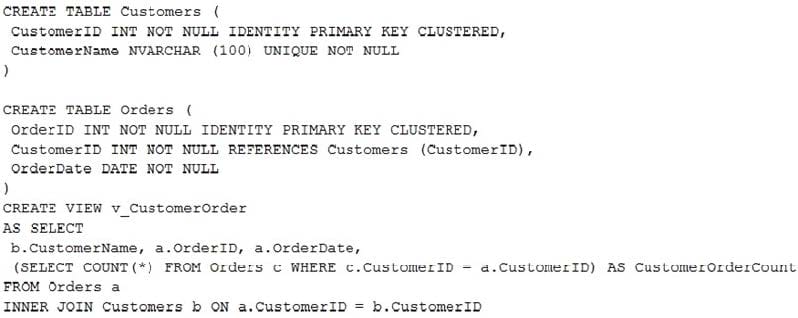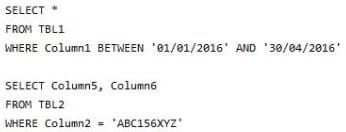Exam Details
Exam Code
:70-762Exam Name
:Developing SQL DatabasesCertification
:Microsoft CertificationsVendor
:MicrosoftTotal Questions
:182 Q&AsLast Updated
:Jan 29, 2022
Microsoft Microsoft Certifications 70-762 Questions & Answers
-
Question 71:
You have multiple stored procedures inside a transaction.
You need to ensure that all the data modified by the transaction is rolled back if a stored procedure causes a deadlock or times out.
What should you do?
A. Use the NOLOCK option.
B. Execute the DBCC UPDATEUSAGE statement.
C. Use the max worker threads option.
D. Use a table-valued parameter.
E. Set SET ALLOW_SNAPSHOT_ISOLATION to ON.
F. Set SET XACT_ABORT to ON.
G. Execute the ALTER TABLE T1 SET (LOCK_ESCALATION = AUTO); statement.
H. Use the OUTPUT parameters.
-
Question 72:
You run the following Transact-SQL statements:

Records must only be added to the Orders table by using the view. If a customer name does not exist, then a new customer name must be created. You need to ensure that you can insert rows into the Orders table by using the view.
A. Add the CustomerID column from the Orders table and the WITH CHECK OPTION statement to the view.
B. Create an INSTEAD OF trigger on the view.
C. Add the WITH SCHEMABINDING statement to the view statement and create a clustered index on the view.
D. Remove the subquery from the view, add the WITH SCHEMABINDING statement, and add a trigger to the Orders table to perform the required logic.
-
Question 73:
You run the following Transact-SQL statement:

There are multiple unique OrderID values. Most of the UnitPrice values for the same OrderID are different.
You need to create a single index seek query that does not use the following operators: Nested loop Sort Key lookup
Which Transact-SQL statement should you run?
A. CREATE INDEX IX_OrderLines_1 ON OrderLines (OrderID, UnitPrice) INCLUDE (Description, Quantity)
B. CREATE INDEX IX_OrderLines_1 ON OrderLines (OrderID, UnitPrice) INCLUDE (Quantity)
C. CREATE INDEX IX_OrderLines_1 ON OrderLines (OrderID, UnitPrice, Quantity)
D. CREATE INDEX IX_OrderLines_1 ON OrderLines (UnitPrice, OrderID) INCLUDE (Description, Quantity)
-
Question 74:
You are developing an ETL process to cleanse and consolidate incoming data. The ETL process will use a reference table to identify which data must be cleansed in the target table. The server that hosts the table restarts daily.
You need to minimize the amount of time it takes to execute the query and the amount of time it takes to populate the reference table.
What should you do?
A. Convert the target table to a memory-optimized table. Create a natively compiled stored procedure to cleanse and consolidate the data.
B. Convert the reference table to a memory-optimized table. Set the DURABILITY option to SCHEMA_AND_DATA.
C. Create a native compiled stored procedure to implement the ETL process for both tables.
D. Convert the reference table to a memory-optimized table. Set the DURABILITY option to SCHEMA_ONLY.
-
Question 75:
You are designing a stored procedure for a database named DB1.
The following requirements must be met during the entire execution of the stored procedure:
The stored procedure must only read changes that are persisted to the database.
SELECT statements within the stored procedure should only show changes to the data that are made by the stored procedure.
You need to configure the transaction isolation level for the stored procedure.
Which Transact-SQL statement or statements should you run?
A. SET TRANSACTION ISOLATION LEVEL READ UNCOMMITED ALTER DATABASE DB1 SET READ_COMMITED_SNAPSHOT ON
B. SET TRANSACTION ISOLATION LEVEL READ COMMITED ALTER DATABASE DB1 SET READ_COMMITED_SNAPSHOT OFF
C. SET TRANSACTION ISOLATION LEVEL SERIALIZABLE
D. SET TRANSACTION ISOLATION LEVEL READ UNCOMMITED ALTER DATABASE SET READ_COMMITED_SNAPSHOT OFF
-
Question 76:
You are designing a solution for a company that operates retail stores. Each store has a database that tracks sales transactions. You create a summary table in the database at the corporate office. You plan to use the table to record the
quantity of each product sold at each store on each day. Managers will use this data to identify reorder levels for products.
Every evening stores, must transmit sales data to the corporate office. The data must be inserted into the summary table that includes the StoreID, ProductID, Qtysold, Totprodsales, and Datesold columns.
You need to prevent duplicate rows in the summary table. Each row must uniquely identify the store that sold the product and the total amount sold for that store on a specific date.
What should you include in your solution?
A. Create a unique constraint.
B. Create a foreign key constraint to the StoreID column in each of the store tables.
C. Create a rule and bind it to the StoreID column.
D. Create a check constraint.
E. Create a table-valued user-defined function.
-
Question 77:
You have the following stored procedure:

The Numbers table becomes unavailable when you run the stored procedure. The stored procedure obtains an exclusive lock on the table and does not release the lock.
What are two possible ways to resolve the issue? Each correct answer presents a complete solution.
NOTE: Each correct selection is worth one point.
A. Remove the implicit transaction and the SET ANSI_DEFAULTS ON statement.
B. Set the ANSI_DEFAULT statement to OFF and add a COMMIT TRANSACTION statement after the INSERT statement.
C. Add a COMMIT TRANSACTION statement after the INSERT statement.
D. Remove the SET ANSI_DEFAULTS ON statement.
-
Question 78:
You have a database that users query frequently.
The users report that during peak business hours, the queries take longer than expected to execute.
A junior database administrator uses Microsoft SQL Server Profiler on the database server to trace the session activities.
While performing the trace, the performance of the database server worsens, and the server crashes.
You need to recommend a solution to collect the query run times. The solution must minimize the impact on the resources of the database server.
What should you recommend?
A. Increase the free space on the system drive of the database server, and then use SQL Server Profiler on the server to trace the session activities.
B. Collect session activity data by using SQL Server Extended Events.
C. Clean up tempdb, and then use SQL Server Profiler on the database server to trace the session activities.
D. Collect performance data by using a Data Collector Set (DCS) in Performance Monitor.
-
Question 79:
You have a relational data warehouse that contains 1 TB of data.
You have a stored procedure named usp_sp1 that generated an HTML fragment. The HTML fragment contains color and font style.
You need to return the HTML fragment.
What should you do?
A. Use the NOLOCK option.
B. Execute the DBCC UPDATEUSAGE statement.
C. Use the max worker threads option.
D. Use a table-valued parameter.
E. Set SET ALLOW_SNAPSHOT_ISOLATION to ON.
F. Set SET XACT_ABORT to ON.
G. Execute the ALTER TABLE T1 SET (LOCK_ESCALATION = AUTO); statement.
H. Use the OUTPUT parameters.
-
Question 80:
Note: This question is part of a series of questions that use the same or similar answer choices. As answer choice may be correct for more than one question in the series. Each question is independent of the other questions in this series. Information and details provided in a question apply only to that question.
You have a Microsoft SQL Server database named DB1 that contains the following tables:

You frequently run the following queries:

There are no foreign key relationships between TBL1 and TBL2.
You need to minimize the amount of time required for the two queries to return records from the tables.
What should you do?
A. Create clustered indexes on TBL1 and TBL2.
B. Create a clustered index on TBL1.Create a nonclustered index on TBL2 and add the most frequently queried column as included columns.
C. Create a nonclustered index on TBL2 only.
D. Create UNIQUE constraints on both TBL1 and TBL2. Create a partitioned view that combines columns from TBL1 and TBL2.
E. Drop existing indexes on TBL1 and then create a clustered columnstore index. Create a nonclustered columnstore index on TBL1.Create a nonclustered index on TBL2.
F. Drop existing indexes on TBL1 and then create a clustered columnstore index. Create a nonclustered columnstore index on TBL1.Make no changes to TBL2.
G. Create CHECK constraints on both TBL1 and TBL2. Create a partitioned view that combines columns from TBL1 and TBL2.
H. Create an indexed view that combines columns from TBL1 and TBL2.
Related Exams:
62-193
Technology Literacy for Educators70-243
Administering and Deploying System Center 2012 Configuration Manager70-355
Universal Windows Platform – App Data, Services, and Coding Patterns77-420
Excel 201377-427
Excel 2013 Expert Part One77-725
Word 2016 Core Document Creation, Collaboration and Communication77-726
Word 2016 Expert Creating Documents for Effective Communication77-727
Excel 2016 Core Data Analysis, Manipulation, and Presentation77-728
Excel 2016 Expert: Interpreting Data for Insights77-731
Outlook 2016 Core Communication, Collaboration and Email Skills
Tips on How to Prepare for the Exams
Nowadays, the certification exams become more and more important and required by more and more enterprises when applying for a job. But how to prepare for the exam effectively? How to prepare for the exam in a short time with less efforts? How to get a ideal result and how to find the most reliable resources? Here on Vcedump.com, you will find all the answers. Vcedump.com provide not only Microsoft exam questions, answers and explanations but also complete assistance on your exam preparation and certification application. If you are confused on your 70-762 exam preparations and Microsoft certification application, do not hesitate to visit our Vcedump.com to find your solutions here.